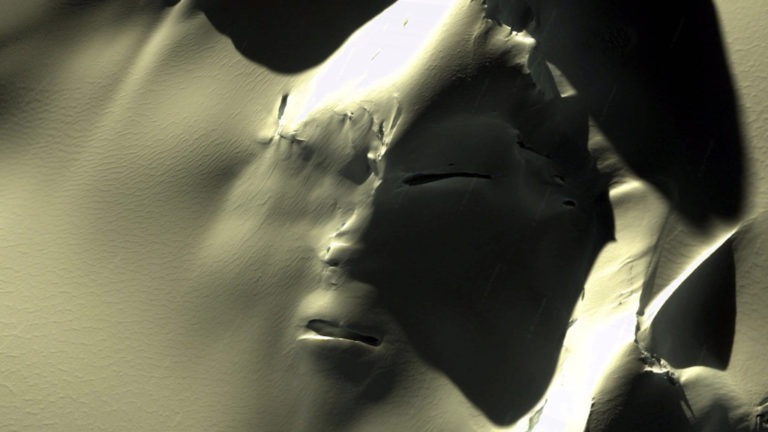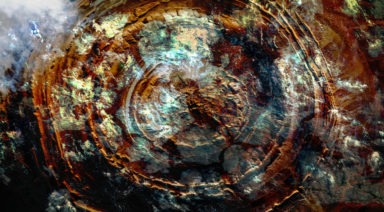Google Earth Image Shows Massive Alien Face In Antarctica

Millions are familiar with the face on the surface of Mars photographed in the red planet’s Cydonia region, but official explanations leave much to be desired and many wondering whether if it’s an artifact from an ancient civilization. But now there is a new face to ponder — one revealed from the melting ice of our planet’s frozen South. What’s being referred to as the “Antarctica Face” is causing quite a commotion among UFO hunters, skeptics, and scientists.
Antarctica Aliens or the Remnants of an Ancient Civilization?
The alien face of Antarctica is a sight to behold. It was discovered by Blake and Brett Cousins, who operate the YouTube channel “Third Phase Of Moon.” The pair has become extraordinarily successful as UFO hunters who frequently scan Google Earth for alien images captured from outer space. The brothers have amassed an impressive following over the years with their videos and commentary on UFO sightings and other strange phenomena, that is also reflected on their Facebook page boasting more than 750,000 followers. As of the first week of September 2019, their video on the Antarctica face alone (originally published on August 20, 2019) already received more than 350,000 views.
The Cousins’ mission, according to their Facebook description, is “to bring unfiltered video, messages & research in the field of ufology directly to the public!” The video of the Antarctica Face is certain to bolster their success and fan base, as well as bring attention to what is already a growing and well-established center of speculation.
In the Cousins’ video of the strange satellite images, Blake states, “It appears to be a massive, ancient structure of some kind of face that is being revealed for the first time on Google Earth.”
The Cousins’ YouTube video is captioned “Grey alien face captured in Google Earth map in Antarctica,”as there are clearly facial features that resemble an eye (with the possibility of the second eye just below the snowy landscape), a nose, and a mouth. Above the face may be a helmet.
Although interest in the Antarctica giant face in the mountains is growing by leaps and bounds, the image is actually not new. The satellite depiction by Google Earth was originally recorded on September 28, 2012, in the Admiralty Mountains not far from Daniell, Hallett, and Adare Peninsulas on the USA’s McMurdo Station side of Antarctica, as noted on the website of famous UFO researcher Linda Moulton Howe. “The McMurdo Station,” the website noted, “is a United States Antarctic research station on the South tip of Ross Island, which is in the New Zealand-claimed Ross Dependency on the shore of McMurdo Sound in Antarctica. The half-mile-long alien face is in the Admirality Mountains at the latitude/longitude upper right between Adare and Hallett Peninsulas.”
A Giant Face or Pareidolia?
Of course, skeptics are always quick to point out that the face is merely a product of erosion, which only looks human because our brains developed to see such things — much like seeing faces in the clouds or interpreting meaningful imagery out of a Rorschach test. The technical term for this is “pareidolia” and is the effect that causes the mind to interpret shapes, structures, and patterns as images that seem familiar.
Live Science explains, “There are a number of theories as to the cause of this phenomenon. Experts say pareidolia provides a psychological determination for many delusions that involve the senses.
Google Earth Mysteries waiting to be seen
The coordinates for the giant face in the snow, that is but one of many google earth mysteries, are 72°00’ 36.00’’ S, 168° 34’ 40.00’’ E, and several Google Earth enthusiasts have suggested that the alien head is about 3520 ft long.
One writer noted, “Sporting what seems to be a proportionate set of eyes, a nose, and a mouth, the eerie ‘visage’ has captured the imagination of conspiracy theorists who contend that Antarctica is home to all manner of esoteric secrets. Numerous observers were quick to note that the potential face bears an uncanny resemblance to the famed ‘Face on Mars’ that is said to sit in the Cydonia region of the Red Planet and was first photographed by NASA’s Viking 1 back in 1976.”
Curiosmos, explained, “Antarctica has become a repository for conspiracy theories, leading many people to speculate about the true nature of the frozen continent. One of the most famous conspiracy theories concerning Antarctica is the alleged, supermassive, snow-topped pyramids lurking in ‘plain sight.’ These alleged structures – which geologists say are no more than natural formations — are said to be the remnants of extremely ancient civilizations that inhabited Earth before our ‘civilization’ came into existence.”
Scientists have reported that Antarctica has lost nearly 3 trillion tons of ice since 1992, and it could very well be that the thaw is beginning to put the frozen South in a new light. Will we start to see more remnants of an ancient civilization as more ice melts?
Chaco Canyon: The Key to Space Travel?

Today, Chaco Canyon is one of the best places in the U.S. to view the stars. Modern-day visitors can stargaze in the same place where ancient peoples once lived and thrived for hundreds of years, without light pollution interfering with the view.
The ability to see the stars so clearly from this 10-mile canyon also fascinated the Anasazi people long ago. An elaborate civilization flourished here between the years 850 and 1250 AD, consisting of numerous, multi-storied stone buildings that were carefully constructed in alignment with the cosmos and cardinal directions.
Although the canyon was inhabited for roughly 400 years by a highly intelligent and sophisticated tribe, its residents vanished without a trace. To this day, no burial grounds or grave yards have been discovered in this isolated canyon and researchers remain puzzled by the sudden disappearance of the ancient society.
Archeologists aren’t the only ones who are interested in this prehistoric civilization and its ancient observatories. NASA has been investigating Chaco Canyon for roughly 40 years. Why would a government agency that’s focused on space exploration have such a vested interest in these ancient ruins? Is it possible that they believe there’s a connection between Chaco Canyon and space travel?
What is Chaco Canyon?
Located in the Four Corners region of New Mexico, Chaco Canyon is a shallow canyon that was once home to ancient Native American peoples about a thousand years ago. What remains of the civilization indicates a highly sophisticated infrastructure that appears to have been constructed in alignment with various celestial bodies. Enormous, elaborate stone buildings housing roughly 700 rooms and numerous underground ceremonial halls (known as “kivas”) are just some of the features that make Chaco Canyon such an extraordinary place.
In addition to its complex construction, one of the great mysteries of the Chaco Canyon society is the rationale for its establishment in the first place. The canyon resides in one of the harshest places on the planet — scorching 100+ degree summers and frigid winters with limited rainfall in between make it extremely impractical for settlement. Why did the ancient Native Americans decide to build such an elaborate community there?
Due to their aptitude for astronomy, it’s possible that the Chacoan people settled in the canyon for the sole purpose of reading the stars — and that’s potentially why NASA is so fascinated by this prehistoric civilization. Perhaps our ancestors were more advanced than once thought.




































